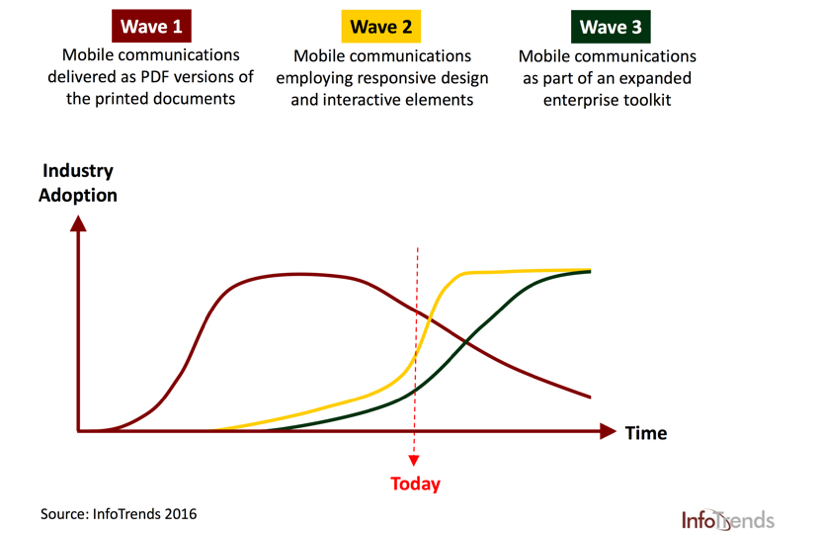
Image by: LittleBee80, ©2016 Getty Images
Ever since the Internet and email became available to consumers, enterprises are expected to provide digital access to business communications, dictated by customer demand. Yet, businesses are also incentivized to shift customers to these lower cost channels. The rise of the smartphone and mobile Internet is only accelerating this trend. We have witnessed three adoption waves for enterprise delivery strategies of mobile communications, as shown in Figure 1.


Figure 1: Adoption Waves of Mobile Communications
Wave 1: The PDF equivalent
In the first wave, enterprises chose the quick-and-easy approach. Long-established print output workflows are quickly adapted to generate a PDF equivalent of the printed document. This PDF document is emailed to customers as an attachment or made available through an online portal. Mobile consumers either receive this PDF document through their smartphone’s email client or by logging into a web portal.
This first wave experienced a steep uptake early on, as enterprises quickly recognized the potential cost savings of not having to send a printed communication. Furthermore, the use of email and the Internet rapidly became a preferred communication channel by consumers, allowing enterprises to leverage these electronic channels.
This first wave experienced a steep uptake early on, as enterprises quickly recognized the potential cost savings of not having to send a printed communication. Furthermore, the use of email and the Internet rapidly became a preferred communication channel by consumers, allowing enterprises to leverage these electronic channels.
Wave 2: Interactive and responsive communications
Recent InfoTrends research, which surveyed more than 800 enterprises across North America, Latin America, and Western Europe, shows that delivering an email with an attachment is one of the most popular channels for electronic customer communications today. That said, other forms of delivery are also gaining popularity, as enterprises steadily shift away from delivering an email with a static PDF attachment and transition to delivering more interactive and responsive communications—the second wave of adoption. Often, this is achieved by using the email channel to deliver a link that takes a customer to communications available on an external portal, which uses responsive HTML to improve the reading experience on devices of varying sizes. Even so, enterprises increasingly provide mobile apps for delivering customer communications to their customers. Based on our research, enterprise respondents expect that delivery via mobile apps will reach parity with email-based communications by 2018.
Wave 3: Mobile communications inside the enterprise toolkit
In the third wave, there is a sustained push by enterprises toward a self-service model within the customer communications space. Such a model is a win-win situation for enterprises and their customers alike. Customers are empowered in the way that they communicate with an enterprise, while enterprises can lower service costs and increase customer engagement. In fact, 2016 research by InfoTrends shows that the use of mobile apps for accessing numerous types of customer service functions is increasing year-over-year.
For example, enterprises cited that the top functions they offer through their mobile apps today are providing access to a list of frequently asked questions (FAQ) or contacting customer service, as well as making purchases and paying bills directly within the app. This same research also indicates that using a mobile app to purely deliver critical communications is becoming less common.
For example, enterprises cited that the top functions they offer through their mobile apps today are providing access to a list of frequently asked questions (FAQ) or contacting customer service, as well as making purchases and paying bills directly within the app. This same research also indicates that using a mobile app to purely deliver critical communications is becoming less common.
Industry adoption is accelerating
Although the majority of customer communications management (CCM) vendors already offer rich, interactive, and responsive communications capabilities through their CCM platforms today, industry adoption is lagging. Enterprises have stuck to PDF equivalents of printed documents, likely, because these implementations are built upon existing print output workflows and, therefore, require less effort and investment to implement and maintain. As such, the second and third adoption waves have experienced a slower uptake.
The business strategy is shifting, however, as enterprises continue to explore delivery cost reduction options and as customer experience becomes of higher strategic importance. Enterprises are making an aggressive push for their customers to go paperless and take advantage of the various access points (including mobile communications) to improve customer experience. As such, we expect the adoption of interactive and responsive communications (wave two) will experience strong growth in the coming year, especially since CCM vendors are already positioned to offer interactive and responsive solutions to their clients.
The business strategy is shifting, however, as enterprises continue to explore delivery cost reduction options and as customer experience becomes of higher strategic importance. Enterprises are making an aggressive push for their customers to go paperless and take advantage of the various access points (including mobile communications) to improve customer experience. As such, we expect the adoption of interactive and responsive communications (wave two) will experience strong growth in the coming year, especially since CCM vendors are already positioned to offer interactive and responsive solutions to their clients.
Moving toward mobile enterprise toolkits
We expect that the rise of the second wave will drive an increased general acceptance of mobile business communications among consumers. This is a key prerequisite for the third wave in which mobile apps act as modern “Swiss Army Knives” that provide 24/7/365 support for enterprise customers through their smartphones. This third wave will push the customer communications industry to go beyond data-driven and personalized communications. Mobile apps will be the front-end of the digital enterprise and also act as the enterprise’s proverbial business card. This will likely accelerate the consolidation of transactional and promotional communication domains and will require customer communications to support all mobile touchpoints throughout the customer journey (customer acquisition-related and customer retention-related)—a development that we already see happening today. These are exciting times for mobile communications and CCM!
David Stabel is an Associate Director for InfoTrends’ Customer Engagement Technologies advisory service. Contact him at david.stabel@infotrends.com or follow him on twitter @davidstabel.
David Stabel is an Associate Director for InfoTrends’ Customer Engagement Technologies advisory service. Contact him at david.stabel@infotrends.com or follow him on twitter @davidstabel.
















